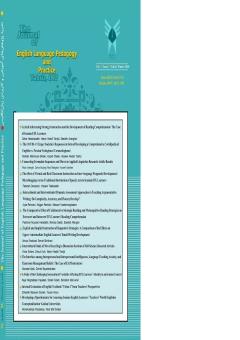The Effects of Supplemental Blended Learning on Listening Comprehension in Iranian EFL Learners
Subject Areas : آموزش زبان انگلیسی
Saeid Najafi Sarem
1
![]() ,
Hamid Omidikia
2
,
Amir Hossein Lotfi
3
,
Hamid Omidikia
2
,
Amir Hossein Lotfi
3
![]()
1 -
2 -
3 -
Keywords: Supplemental Blended Learning, Listening Comprehension, Iranian EFL Learner,
Abstract :
This study explores the impact of supplementary blended learning on the listening comprehension skills of Iranian English as a Foreign Language (EFL) learners. A sample of 60 male Iranian EFL learners was selected from a population of 100 learners studying English at Pardis Language Institute, Hamadan, Iran, via double-stage sampling. After being selected, participants were sorted into two groups, that is, a control group and an experimental group. In the treatment sessions, all participants listened to parts of the American English File (book 2). The participants in the control group received the usual procedure of teaching listening in the institute. In the experimental group, the students received target language input via videos and supplementary reading materials before classes so that they had sufficient exposure to the input. The listening topics were uploaded on a common social networking site, i.e., the telegram application, which was also reserved for giving teachers feedback on the students’ questions. The results of the data analysis showed that supplemental blended learning had a statistically significant effect on EFL learners’ listening comprehension. In other words, the research question was answered positively, and the corresponding null hypothesis was rejected.
Abaeian, I., & Samadi, M. (2016). The impact of blended learning on reading comprehension performance of Iranian EFL learners with different proficiency levels. Educational Technology & Society, 19(3), 187-198.
Al-Jarf, R. (2007). The effect of blended learning on college readers. International Journal of Instructional Technology and Distance Learning, 4(3), 29-38.
Anderson, A., & Lynch, T. (1988). Listening. Oxford: Oxford University Press.
Behjat, F., Yamini, M., & Bagheri, M. S. (2011). Blended learning: A ubiquitous learning environment for reading comprehension. International Journal of English Linguistics, 1(1), 103–110.
Buck, G. (2001). Assessing listening. Cambridge: Cambridge University Press.
Garrison, D. R., & Vaughan, N. D. (2008). Blended learning in higher education: Framework, principles, and guidelines. San Francisco: Jossey-Bass.
Ghahari, S., & Ameri-Golestan, A. (2014). The impact of blended teaching methods on Iranian EFL learners’ writing performance. Journal of Teaching Language Skills, 6(3), 1-20.
Ghazizadeh, H., & Fatemipour, A. (2017). The effect of blended learning on the reading proficiency of Iranian EFL learners. International Journal of Language Learning and Applied Linguistics World, 14(1), 29-35.
Haghighi, J., Jafarigohar, M., Khoshsima, H., & Vahdany, F. (2018). The impact of a blended learning classroom on enhancing EFL learners’ pragmatic competence. Journal of Language and Linguistic Studies, 14(2), 76-88.
Hsieh, J. S., Wu, W. C. V., & Marek, M. W. (2016). Using the flipped classroom to enhance EFL learning. Computer Assisted Language Learning, 29(1), 1-21. https://doi.org/10.1080/09588221.2014.967701
Jia, Y., Chen, H., Ding, X., & Ruan, H. (2012). A study of individualized vocabulary acquisition and assessment in blended learning environments. International Journal of Emerging Technologies in Learning, 7(1), 32-36.
Kazu, I., & Demirkol, M. (2014). The effect of blended learning on high school students' academic achievement. Educational Research and Reviews, 9(4), 66-75.
Mendelsohn, D. (1998). Teaching listening. Annual Review of Applied Linguistics, 18, 81-101.
Neumeier, P. (2005). A closer look at blended learning: Parameters for designing a blended learning environment for language teaching and learning. ReCALL, 17(2), 163-178.
O’Flaherty, J., & Phillips, C. (2015). The use of flipped classrooms in higher education: A scoping review. The Internet and Higher Education, 25, 85-95. https://doi.org/10.1016/j.iheduc.2015.02.002
O’Malley, J. M., & Chamot, A. U. (1990). Learning strategies in second language acquisition. Cambridge: Cambridge University Press.
Rahmawati, I. (2019). Exploring students’ voice on blended learning implementation in the listening and speaking course. Journal of English Language Teaching, 8(2), 113-123.
Richards, J. C., & Trew, G. (2011). Basic Tactics for Listening (3rd ed.). Oxford: Oxford University Press.
Rost, M. (2002). Teaching and researching listening. Harlow: Longman.
Shih, J. (2011). The effect of Web 2.0 technology on the development of EFL learners’ writing skills. Computer Assisted Language Learning, 24(1), 1-14.
Sholihah, R., Permadi, A., & Umamah, S. (2018). The effectiveness of blended learning strategy by integrating portfolio-based extensive listening activity. Indonesian Journal of EFL and Linguistics, 3(2), 131-142.
Soltani, S., Tehrani, M. M., & Tabatabaei, O. (2012). The effect of blended learning on Iranian EFL learners' vocabulary achievement. Journal of Teaching English as a Foreign Language, 2(1), 72-81.
Vandergrift, L. (2007). Recent developments in second and foreign language listening comprehension research. Language Teaching, 40(3), 191–210.


